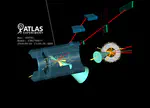Observing

This project was funded by the Royal Society of Edinburgh under the Saltire Early Career Research Fellowship scheme.
The top quark is the most massive fundamental particle in the Standard Model (SM), and is highly unstable. Its lifetime is in fact shorter than the typical interaction time of the strong nuclear force (QCD), which means that it decays before undergoing hadronisation. While any other quark would have seen their quantum properties (“spin”) diluted and randomised by being forced into colour-neutral composite objects (“hadrons”), the top quark is able to transfer this information, intact, to its decay products. Since the top quark is mostly produced in pairs at the LHC, through the
With fellow top spin expert James Howarth (Glasgow) and his PhD student Ethan Simpson, I started looking at the top process I know best: top pair production in association with a
- spin correlations are very different in
- a small polarisation of the top quarks is induced by the
- measuring the full spin density matrix can provide a new way of constraining the SM Effective Field Theory (SMEFT)
This last item is of great interest, since no sign of new particles have been observed at the ATLAS experiment so far – we can therefore benefit from using precision measurements to constrain the SMEFT and guide our future searches. In this same paper, I also computed the degree of confidence (the “Bayesian

The topic of my RSE Saltire Fellowship is precisely to use the LHC Run 2 ATLAS dataset to look for this effect. It is an experimentally challenging measurement, with a very feeble signal (almost a thousand times rare than

